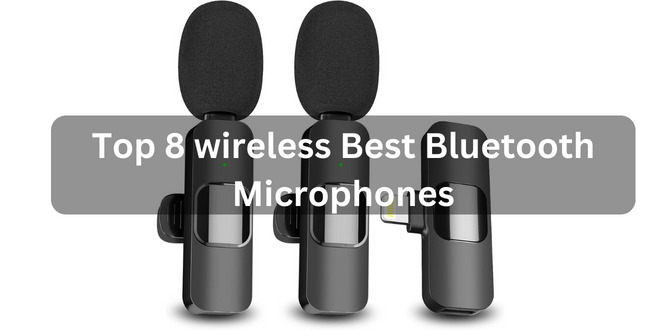UHF wireless microphones utilize Ultra High-Frequency technology to transmit audio signals wirelessly. Unlike traditional wired microphones, UHF wireless microphones operate in the frequency range of 300 MHz to 3 GHz, allowing for robust and reliable audio transmission without the constraints of physical cables. This technology has revolutionized various industries by providing seamless mobility and high-quality sound reproduction.
History Of UHF wireless Microphones
Since they were first made in the early 20th century, wireless microphones have come a long way. UHF (Ultra frequency) wireless microphones work between 300 MHz and 3 GHz.
In the 1960s, the Shure Brothers Company made one of the first UHF wireless microphones. This microphone had a UHF frequency band and was made for professional audio uses like live performances and radio and TV broadcasting.
Since the 1960s, UHF wireless microphones have become more and more popular for use in live performances, TV and movie production, and corporate events, among other things. UHF wireless microphones are known for having a long-range and being able to reach through walls and other solid objects. This makes them a good choice for large venues and other difficult settings.
In recent years, newer technologies like digital wireless microphones and Wi-Fi-based systems have become more and more of a threat to UHF wireless microphones. But UHF wireless microphones are still popular because they work well and are easy to find.
Importance of UHF Technology in Wireless Microphones
UHF technology is pivotal in wireless microphones due to its exceptional capabilities. The high-frequency range allows clear, interference-free audio signals to be transmitted over long distances. This is particularly crucial in professional settings where audio quality, such as live performances, broadcasting, and corporate events, cannot be compromised. The ability to operate multiple UHF microphones simultaneously without signal degradation is a testament to its reliability, making it a preferred choice among professionals.
Understanding UHF Wireless Microphones
What is UHF Technology?
UHF, or Ultra High Frequency, refers to electromagnetic waves in the frequency range between 300 MHz (Megahertz) and 3 GHz (Gigahertz). In the context of wireless microphones, UHF technology enables the transmission of audio signals without the need for physical cables. UHF wireless microphones use these frequencies to carry audio data, allowing for precise, reliable, and high-quality sound transmission over extended distances. This technology employs modulation techniques to encode audio signals onto UHF waves, ensuring seamless communication between microphones and receivers.
How UHF Differs from VHF (Very High Frequency) in Wireless Microphones
UHF and VHF are frequency bands in wireless communication systems, including microphones. However, UHF has distinct advantages over VHF, especially in crowded and interference-prone environments. Unlike VHF, UHF frequencies can more effectively penetrate obstacles like walls and other structures. UHF signals are less susceptible to interference from electronic devices and other wireless systems, providing a more stable and precise audio transmission. This makes UHF wireless microphones the preferred choice for professional applications where reliable and interference-free communication is essential.
Advantages of UHF over Other Frequencies
- Reduced Interference: UHF signals experience less interference from electronic devices and other radio frequency sources, ensuring a clear audio transmission.
- Wider Bandwidth: The UHF frequency range offers a broader bandwidth, allowing more channels to operate simultaneously without overlapping and causing interference.
- More excellent Range: UHF signals can cover more considerable distances without significant signal degradation, making them ideal for events in spacious venues.
- Improved Penetration: UHF waves can penetrate obstacles more effectively, ensuring a stable connection even in complex environments with walls and obstructions.
- Technical Aspects: Frequencies, Channels, and Bandwidth
- Frequencies: UHF frequencies used in wireless microphones typically range from 470 MHz to 952 MHz. Different frequency bands are allocated for wireless microphone use in different regions to avoid interference with other wireless devices.
- Channels: UHF wireless microphones operate on multiple channels within the available frequency range. Each track represents a specific frequency within the UHF band. Users can select different channels to avoid interference with nearby wireless systems.
- Bandwidth: UHF technology offers a broader bandwidth than lower frequency bands like VHF. This wider bandwidth allows for transmitting more data, including high-quality audio signals, resulting in superior sound quality.
Benefits of UHF Wireless Microphones
High-Quality Audio Transmission
Reduced Interference and Better Signal Quality
UHF wireless microphones offer superior audio quality by minimizing interference from other electronic devices. The high frequency and advanced modulation techniques ensure a stable and precise signal transmission. This reduction in interference results in pristine sound quality, making UHF microphones ideal for professional audio recordings, live performances, and broadcasting.
Suitable for Professional Audio Applications
Due to their excellent signal quality, UHF wireless microphones are widely used in professional settings. Musicians, public speakers, broadcasters, and sound engineers prefer UHF technology for its ability to capture and transmit audio with exceptional clarity and fidelity. Whether in a concert hall, TV studio, or conference room, UHF microphones deliver the professionalism and reliability professionals demand.
Extended Range and Coverage
Improved Range for Large Venues and Outdoor Events
UHF wireless microphones are designed to cover extensive distances without compromising signal strength. This extended range is crucial for events held in large venues such as stadiums, theaters, and outdoor arenas. Regardless of the venue’s size, UHF microphones ensure that performers and speakers can move freely without worrying about signal loss.
Minimized Signal Dropouts
UHF technology minimizes signal dropouts, ensuring a continuous and uninterrupted audio transmission. This feature is especially vital during live performances or important presentations where a seamless audio flow is essential. By reducing signal dropouts, UHF wireless microphones provide a reliable communication channel between the microphone and the receiver, enhancing the overall user experience.
Flexibility and Versatility
Multiple Channels for Simultaneous Microphone Usage
UHF wireless microphones offer the flexibility of operating on multiple channels within the UHF frequency range. This means that various microphones can be used simultaneously without interfering with each other. In scenarios involving panel discussions, interviews, or musical ensembles, UHF microphones allow each participant to have their dedicated channel, ensuring clear communication without cross-channel interference.
Compatibility with Various Audio Devices
UHF wireless microphones are compatible with various audio devices, including mixers, amplifiers, and recording equipment. This compatibility allows users to integrate UHF microphones into their existing audio setups seamlessly. Whether connecting to a sound system in a concert venue or recording audio in a studio, UHF microphones provide versatile options for various audio applications, making them a preferred choice among professionals.
Common Uses and Applications
Entertainment Industry
Live Concerts and Music Performances
UHF wireless microphones are indispensable in the live music industry. Artists and musicians rely on UHF microphones to deliver crystal-clear vocals and instrumentals to the audience. The extended range and minimized signal dropouts ensure that performers can move freely on stage without compromising audio quality. UHF microphones capture the nuances of live performances, providing an immersive experience for the audience.
Theatrical Productions and Musical Show
Theatrical productions and musical shows demand high-quality audio for dialogues, songs, and sound effects. UHF wireless microphones are extensively used in theaters and musical productions to amplify actors’ voices and musical performances. The flexibility of UHF technology allows actors and performers to wear discreet microphones, enhancing the overall sound quality of the production. UHF microphones are also favored in musicals for their ability to capture intricate musical arrangements with precision.
Corporate and Educational Settings
Business Presentations and Conferences
UHF wireless microphones are employed in corporate settings during business presentations, conferences, and seminars. Presenters can confidently move around the stage or podium, addressing the audience without being restricted by cables. UHF microphones ensure that the presenter’s voice is audible to all attendees, enhancing the effectiveness of the presentation. The reliability of UHF technology is crucial in professional environments where a seamless flow of communication is paramount.
Lectures and Educational Seminar
UHF wireless microphones are vital in educational settings, especially in lecture halls and auditoriums. Educators and speakers use UHF microphones to ensure every student can hear the lecture. This is particularly important in large classrooms where sound dispersion can be challenging. UHF microphones help maintain students’ attention by delivering a consistent and audible voice, facilitating compelling learning experiences.
Broadcasting and Filmmaking
Television and Radio Production
UHF wireless microphones are extensively utilized in television and radio production studios. News anchors, reporters, and guests use UHF microphones to deliver news, interviews, and commentary with exceptional clarity. UHF technology’s reduced interference and high-quality audio transmission ensure that broadcasts are professional and seamless. UHF microphones are also preferred for talk shows, ensuring that the audience hears every word.
Film and Documentary Making
Filmmakers and documentary producers rely on UHF wireless microphones to capture dialogue and ambient sounds during filming. UHF microphones are often used to record actors’ lines, ensuring that the final film’s conversations are clear and distinct. Additionally, UHF microphones capture natural sounds and background noises in documentaries, adding depth and realism to the audio. UHF technology’s reliability and flexibility contribute to the quality of film and documentary productions.
UHF wireless microphones enhance audio quality across diverse applications, making them a staple in the entertainment, corporate, educational, broadcasting, and filmmaking industries.
Tips for Choosing the Right UHF Wireless Microphone
Before selecting a UHF wireless microphone, it’s crucial to assess your specific requirements and applications:
- Identify Your Purpose: Determine the primary use of the microphone (e.g., live performances, presentations, filming) to choose a microphone tailored to that purpose.
- Evaluate Range Requirements: Consider the size of the venues where you will be using the microphone. Larger venues may require microphones with extended-range capabilities.
- Number of Microphones Needed: If you require multiple microphones, ensure that the chosen UHF system supports the channels without interference.
- Consider Battery Life: Evaluate the microphone’s battery life, especially for events lasting several hours. Opt for models with long-lasting batteries or convenient recharging options.
Researching Reliable Brands and Models
Researching reputable brands and specific models is essential to ensure the reliability and performance of your UHF wireless microphone system:
- Read Reviews and Testimonials: Look for reviews and testimonials from professionals in your industry. Feedback from experienced users can provide valuable insights.
- Check for Industry Standards: Verify if the microphone system complies with industry standards and regulations to guarantee its quality and legality of use.
- Consider Brand Reputation: Choose well-established and reputable brands known for their durable and high-quality microphone systems. Established brands often provide better customer support and warranty services.
- Budgetary Considerations and Value for Money
Budgetary Considerations and Value for Money
Balancing your budget with the features and quality of the microphone system is essential for obtaining value for your money:
- Set a Realistic Budget: Determine your budget range based on your requirements. While opting for the cheapest option is tempting, investing in a slightly higher-priced, reliable system can save you from future complications.
- Compare Features: Compare the features offered by different models within your budget. Focus on essential elements such as range, frequency stability, interference resistance, and ease of use.
- Consider Long-Term Costs: Factor in potential long-term costs, such as maintenance, replacement parts, and accessories. Sometimes, a slightly higher initial investment can lead to cost savings in the long run by avoiding frequent replacements and repairs.
By carefully considering your needs, researching reputable brands, and balancing your budget, you can choose the right UHF wireless microphone that meets your requirements and provides excellent value for your investment.
Maintenance and Best Practices
Proper handling and care are essential to ensure the longevity and optimal performance of your UHF wireless microphone:
- Avoid Dropping and Rough Handling: Handle the microphone carefully, avoiding accidental drops or impacts that can damage internal components.
- Protect from Moisture and Extreme Temperatures: Keep the microphone away from moisture and extreme temperatures to prevent damage to the circuitry and internal components.
- Use a Protective Case: When not in use, store the microphone in a protective case to shield it from dust, dirt, and physical damage.
- Secure Microphone Placement: Use microphone stands or mounts to secure the microphone during performances, preventing accidental falls.
Regular Maintenance to Ensure Longevity
Regular maintenance is crucial to keep your UHF wireless microphone in optimal condition for an extended period:
- Clean Microphone Grille: Regularly clean the microphone grille using a soft brush or a windscreen to remove dirt, dust, and debris. A clean grille ensures clear sound transmission.
- Check and Replace Batteries: Monitor the battery life and replace batteries as needed to prevent unexpected power failures during performances or events.
- Inspect Cables and Connectors: Periodically check the microphone cables and connectors for signs of wear or damage. Replace damaged lines promptly to maintain a reliable connection.
- Update Firmware (if applicable): If your UHF microphone system has Firmware, ensure it is up-to-date. Manufacturers may release firmware updates to improve performance and address issues.
Troubleshooting Common Issues and Solutions
Being aware of common issues and their solutions can help you troubleshoot problems effectively:
- Interference Issues: If you experience interference, change the microphone’s channel to avoid overlapping frequencies with nearby devices. Ensure other electronic devices are not causing the interference.
- No Audio Output: Check the microphone, receiver, and cables for proper connections. Replace batteries and inspect cable integrity. If issues persist, consult the user manual or contact customer support.
- Distorted Sound: Distorted sound can result from overloading the microphone input. Adjust the microphone’s gain settings and ensure compatibility with the audio equipment it’s connected to.
- Dropouts in Signal: Signal dropouts may occur due to obstacles or interference. Reposition the microphone and receiver, ensuring a clear line of sight between them. If issues persist, consider upgrading to a higher-quality UHF system.
By following these best practices, performing regular maintenance, and troubleshooting common issues effectively, you can maximize the lifespan and performance of your UHF wireless microphone, ensuring reliable and high-quality audio transmission during various applications.
Conclusion
In conclusion, UHF wireless microphones offer many advantages that make them indispensable in various professional and entertainment settings. UHF technology stands at the forefront of wireless audio solutions, from delivering high-quality audio transmission with reduced interference to providing extended range and coverage for large venues and outdoor events. The flexibility of UHF microphones, allowing for multiple channels and compatibility with diverse audio devices, ensures seamless and versatile usage across different applications.
The importance of choosing UHF technology cannot be overstated. Its ability to provide reliable, interference-free, and transparent audio makes it the preferred choice for musicians, performers, educators, broadcasters, and professionals across industries. UHF wireless microphones enhance the overall audio experience and empower individuals to deliver their best performances, presentations, and productions without the constraints of wired systems or the worries of signal disruptions.
What is a UHF wireless microphone?
Ultra-high frequency (UHF) wireless microphone sets work between 450 Mhz and 952 Mhz. Compared to Very High Frequency (VHF) mics, they have a more stable connection. Sound interference can also happen with VHF microphones.
Pros of a UHF wireless microphone
UHF wireless microphones are usually made to be small and portable so that they can be used in various places.
- Simplified Setup: UHF technology offers straightforward setup and ease of use, with minimal configuration required.
- Extended Range: UHF devices are renowned for their extended range, capable of penetrating obstacles like walls, making them ideal for large venues and challenging environments.
- High Sound Quality: UHF technology ensures high-quality sound transmission, making it suitable for professional applications such as live performances, broadcasting, and recording.
- Multiple Channels: Many UHF devices provide multiple channels, allowing users to select different frequencies for various scenarios and avoid interference from other wireless equipment.
- Diversity Reception: Some UHF devices employ dual antennas for diversity reception, enhancing reliability and extending signal range.
- Automatic Frequency Selection: Certain UHF devices feature automatic frequency selection to ensure interference-free, clear signal transmission.
- Compact Portability: UHF technology is often packaged in compact, portable designs, enabling versatile use in various locations.
Cons of a UHF wireless microphone
- Limited frequency range: Wireless microphones operating within a narrow frequency range may be suitable for specific applications only.
- Potential for interference: Interference from other devices utilizing the same frequency range as wireless microphones can disrupt their performance.
- Limited channels: The finite number of available channels for wireless microphones can restrict the simultaneous use of multiple microphones.
- Cost: Wireless microphone systems, such as VHF (Very High Frequency) systems, might be more expensive compared to alternative wireless microphone options.
- Complex setup: Setting up certain wireless microphone systems can be intricate, requiring time, specialized knowledge, or specific equipment.
- Battery life: Some wireless microphones may have shorter battery life, which could be problematic in certain situations.
How to connect a wireless microphone to an analog mixer?
Turn off the wireless microphone system and the mixer.
Use a 3.5 mm or XLR cable to connect the wireless microphone transmitter to the mixer.
Set the wireless microphone system to the same frequency as the wireless microphone receiver and turn it on.
Turn on the mixer and set the channel where the wireless microphone is connected to the “Mic” or “Line” level, depending on the output of the wireless microphone transmitter.
Change the mixer’s volume and tone controls to the settings you want.
Talk into the wireless microphone and look at the level of the mixer’s meters. If the level is too low or too high, adjust the gain on the transmitter of the wireless microphone or the channel volume on the mixer.
Once you’ve set up and tested the wireless microphone, you can use it to make your voice or other sounds louder through the mixer and any speakers or amplifiers you’ve connected.




